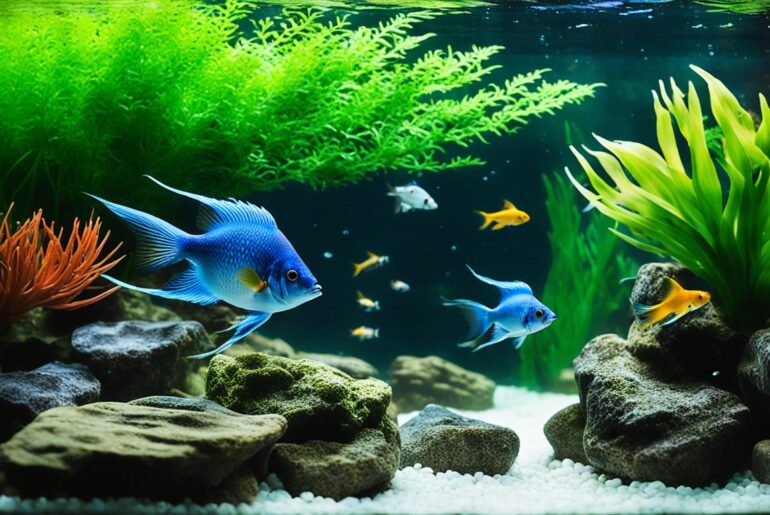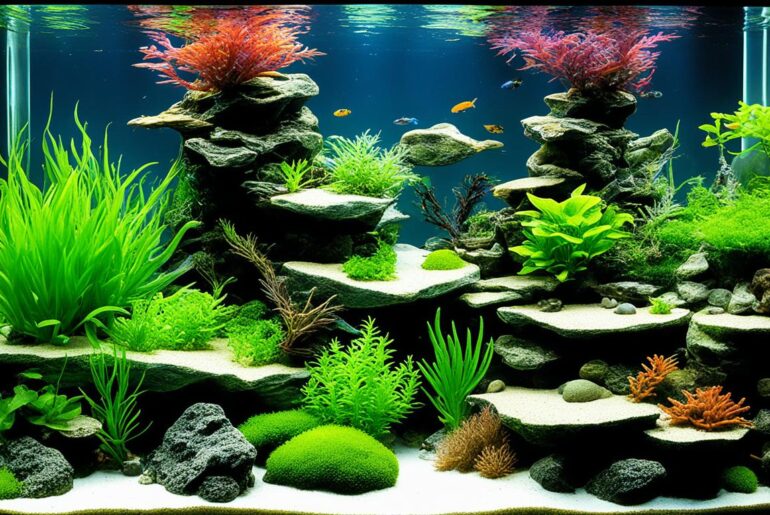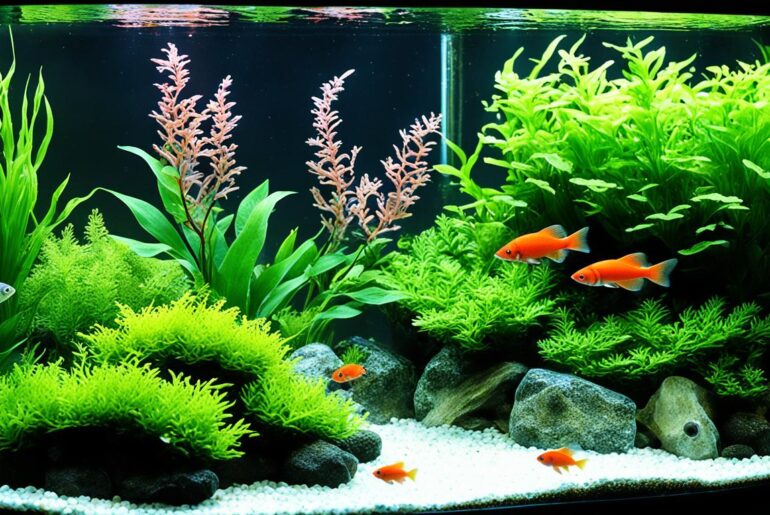Have you ever dreamed of creating a vibrant underwater world, teeming with colorful fish and lush aquatic plants? I certainly have. It was a childhood fascination that grew with me into adulthood. But like many aquarium enthusiasts, I faced the challenges of maintaining a healthy and thriving aquatic ecosystem.
When I first started, I struggled to understand why my fish seemed stressed and my plants struggled to grow. That’s when I learned about the importance of aquarium cycling and how it can make all the difference in creating a balanced and safe environment for our beloved aquatic friends.
Today, I want to share with you three DIY techniques for successful aquarium cycling. These techniques are tried and tested, and they will help you establish a thriving and harmonious underwater world that you can be proud of.
Key Takeaways:
- Understanding the nitrogen cycle is crucial for maintaining a healthy aquarium environment.
- A cycled tank with established beneficial bacteria is essential for the well-being of your aquatic inhabitants.
- Fishless cycling methods are humane and effective alternatives to fish-in cycling.
- Monitoring water parameters and using the right tools will expedite the cycling process.
- A mature aquarium offers numerous benefits, including improved water quality and a stable ecosystem.
The Nitrogen Cycle Explained
The nitrogen cycle is a fascinating natural process that plays a vital role in maintaining a healthy aquarium ecosystem. Understanding how this cycle works is crucial for every aquarium enthusiast, as it helps prevent the buildup of harmful ammonia and ensures the well-being of your aquatic inhabitants.
At the heart of the nitrogen cycle is fish waste. When your fish eat and produce waste, it releases ammonia into the water. Ammonia is highly toxic to fish and can quickly become lethal if left unchecked. However, nature has its way of dealing with this issue.
The nitrogen cycle:
To put it simply, the nitrogen cycle involves a series of chemical transformations that convert ammonia into less harmful substances. Here’s how it works:
- Ammonia: Fish waste and decaying matter release ammonia (NH3) into the water. This highly toxic compound can cause severe harm to aquatic life.
- Nitrite: During the cycling process, beneficial bacteria called Nitrosomonas convert ammonia into nitrite (NO2), which is still harmful but less toxic than ammonia.
- Nitrate: Another group of beneficial bacteria, known as Nitrobacter, convert nitrite into nitrate (NO3). Nitrate is relatively harmless to fish as long as its levels remain within acceptable limits.
By facilitating the conversion of ammonia into nitrite and then nitrate, the nitrogen cycle ensures that toxic compounds are progressively transformed into less harmful substances. In a balanced and healthy aquarium, these transformations occur continuously, maintaining water quality and ensuring the well-being of your fish.
The nitrogen cycle visualized:
| Stage | Substance | Bacteria Involved |
|---|---|---|
| 1 | Ammonia (NH3) | Nitrosomonas |
| 2 | Nitrite (NO2) | Nitrosomonas |
| 3 | Nitrate (NO3) | Nitrobacter |
The Importance of a Cycled Tank
A cycled tank is the cornerstone of a balanced and healthy aquarium. It plays a crucial role in maintaining optimal water quality and creating a thriving environment for your aquatic friends. So, what exactly is a cycled tank and why is it so important?
A cycled tank refers to an aquarium where the nitrogen cycle is actively occurring. This cycle involves the transformation of harmful ammonia, produced by fish waste and decaying matter, into less toxic substances such as nitrite and nitrate. And here’s where beneficial bacteria enter the picture.
Beneficial bacteria are the unsung heroes of the aquarium world. These microscopic organisms establish themselves in your tank and form colonies on various surfaces, including the substrate, filter media, and decorations. They play a vital role in the nitrogen cycle by converting toxic ammonia and nitrite into nitrate, which is less harmful to your aquatic inhabitants.
Having a cycled tank provides numerous benefits to your aquarium ecosystem. It helps maintain stable water parameters and prevents ammonia and nitrite spikes that can be fatal to fish and other aquatic organisms. The conversion of ammonia into nitrate reduces the risk of water pollution and creates a more balanced environment for your beloved underwater creatures.
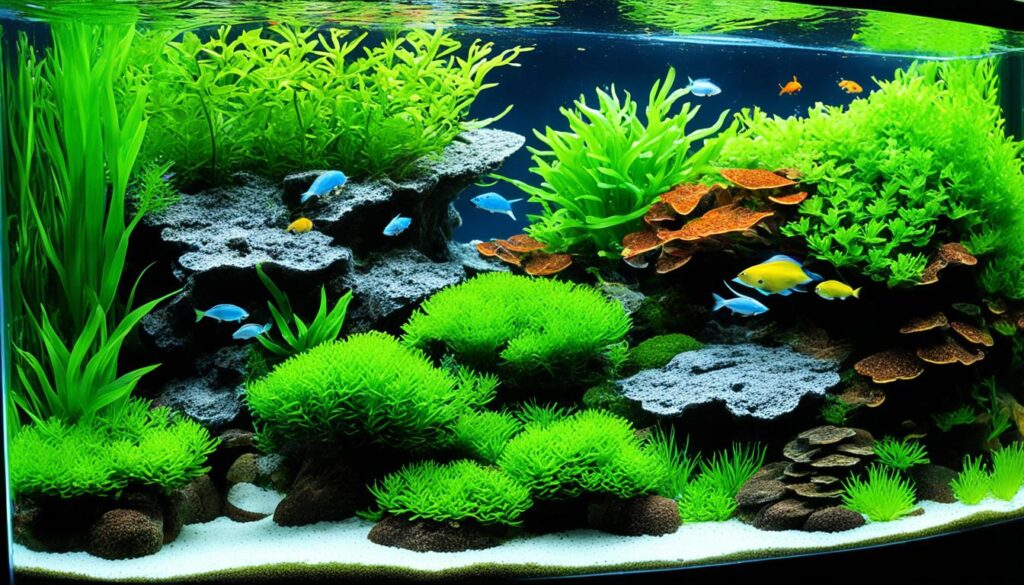
By maintaining a cycled tank, you ensure that your aquarium is a safe and comfortable habitat for your fish, shrimp, and plants. It mimics the natural balance found in their native environments and promotes their overall well-being.
A balanced and healthy aquarium not only benefits your aquatic inhabitants but also offers a visually appealing and enjoyable experience for you as the aquarium keeper. The vibrant colors, active behavior, and lush vegetation in a well-cycled tank bring beauty and tranquility to any space.
Investing the time and effort into establishing a cycled tank is vital for a successful and fulfilling aquatic endeavor. The benefits far outweigh the initial setup process, and you’ll be rewarded with a stunning underwater paradise.
Benefits of a Cycled Tank
| Benefits | Description |
|---|---|
| Improved Water Quality | Beneficial bacteria convert toxic ammonia and nitrite into less harmful nitrate, maintaining healthy water conditions. |
| Stable Ecosystem | A cycled tank creates a balanced environment, reducing stress on your fish and other aquarium inhabitants. |
| Enhanced Fish Health | The absence of toxic ammonia and nitrite helps promote the overall well-being and disease resistance of your fish. |
| Lush Plant Growth | The presence of beneficial bacteria and stable water conditions support the growth of vibrant and healthy aquatic plants. |
| Visually Appealing | A cycled tank showcases vibrant colors, active behavior, and thriving vegetation, creating a stunning display in your home or office. |
In the next section, I’ll guide you through the fishless cycling methods, which are humane and effective ways to establish a cycled tank without exposing your fish to potential harm. Stay tuned!
Fishless Cycling Methods
Fishless cycling is a humane and effective method for establishing a healthy nitrogen cycle in your aquarium. It allows you to introduce beneficial bacteria and kickstart the cycling process without exposing your fish to harmful ammonia. There are several fishless cycling methods you can choose from:
- Ghost Feedings: This method involves adding a small amount of fish food to the tank daily, simulating the presence of fish and providing a source of ammonia for the bacteria to feed on. The food should be left to decompose naturally, allowing the colony of beneficial bacteria to grow and convert the ammonia into nitrite and nitrate.
- Liquid Nitrifying Bacteria: Another option is to add liquid nitrifying bacteria to your tank. These products contain live bacteria cultures that rapidly establish themselves in the aquarium, minimizing the cycling time. Follow the manufacturer’s instructions when using liquid nitrifying bacteria to ensure proper application and dosage.
- Established Filter Media: Transferring established filter media, such as sponge or bio-media, from a mature aquarium to your new tank can also speed up the cycling process. These media already contain an abundance of beneficial bacteria that can quickly colonize the new tank and establish a healthy nitrogen cycle.
To optimize your fishless cycling experience, you can even combine these methods. However, it is important to monitor water parameters regularly to ensure the cycling process is progressing smoothly. With patience and diligence, you’ll be able to establish a thriving aquatic environment for your fish, shrimp, and plants.
Using a fishless cycling method eliminates the stress and potential harm to fish during the initial stages of setting up your aquarium. It allows you to create a stable and safe environment for your aquatic inhabitants, ensuring their long-term health and well-being.
Fish-In Cycle Risks
The fish-in cycle method involves adding fish to the tank during the cycling process. While it can be done successfully, it poses risks to the fish due to the high levels of harmful ammonia that can accumulate in the tank.
“Adding fish during the cycling process can be stressful for them and can expose them to harmful ammonia levels.”
Ammonia is a toxic substance that is released from fish waste and decaying matter. In a fish-in cycle, the high fish density can result in an excess of ammonia, which can be detrimental to the well-being and health of the fish.
It is important to note that some fish species are less hardy and more susceptible to the adverse effects of ammonia. These include delicate and sensitive fish species, such as certain tropical fish.
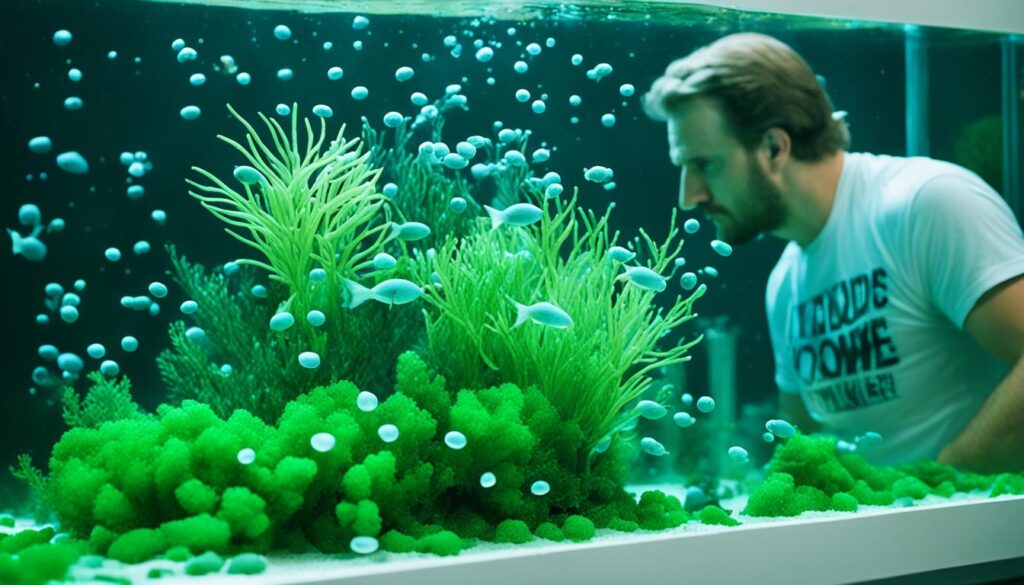
Considering the potential harm to the fish and the importance of maintaining water conditions, the fish-in cycle method is generally not recommended. It is advisable to opt for fishless cycling methods or alternative approaches that prioritize the well-being of your aquatic inhabitants.
| Benefits of Fishless Cycling |
|---|
| Eliminates the risk of harming fish due to high ammonia levels |
| Allows for a controlled and safer cycling process |
| Prevents stress and potential health issues in fish |
| Ensures a smoother transition when introducing fish to the tank |
Cycling Timeframe and Factors
The time it takes to cycle an aquarium can vary depending on several factors, including tank size, water pH, and temperature. These factors play a significant role in the growth and establishment of beneficial bacteria, which are essential for a successful cycling process.
Generally, it takes about four to eight weeks to complete the cycling process. However, it is crucial to note that this timeframe is just an estimate and can vary based on individual tank conditions and other factors.
Monitoring and maintaining optimal water parameters throughout the cycling process can help expedite the growth of beneficial bacteria and reduce the overall cycling time. Let’s take a closer look at how each of these factors can influence the cycling timeframe:
| Factors | Impact on Cycling Timeframe |
|---|---|
| Tank Size | A larger tank may take longer to cycle as there is a larger volume of water for the beneficial bacteria to establish themselves. |
| Water pH | The ideal pH range for the growth of beneficial bacteria is typically between 6.5 and 7.5. Water with extreme pH levels may inhibit bacterial growth and prolong the cycling process. |
| Temperature | Most beneficial bacteria thrive in temperatures between 75°F and 82°F (24°C to 28°C). Lower temperatures can slow down bacterial growth, while higher temperatures can accelerate it. It’s important to maintain a consistent and suitable temperature throughout the cycling process. |
By taking these factors into consideration and creating optimal conditions for bacterial growth, you can help promote a faster and more efficient cycling process.
Continue to monitor water parameters regularly and adjust as needed to ensure the cycling process progresses smoothly. Once the cycling is complete, you can introduce your fish, shrimp, or plants to a healthy and well-established aquarium environment.
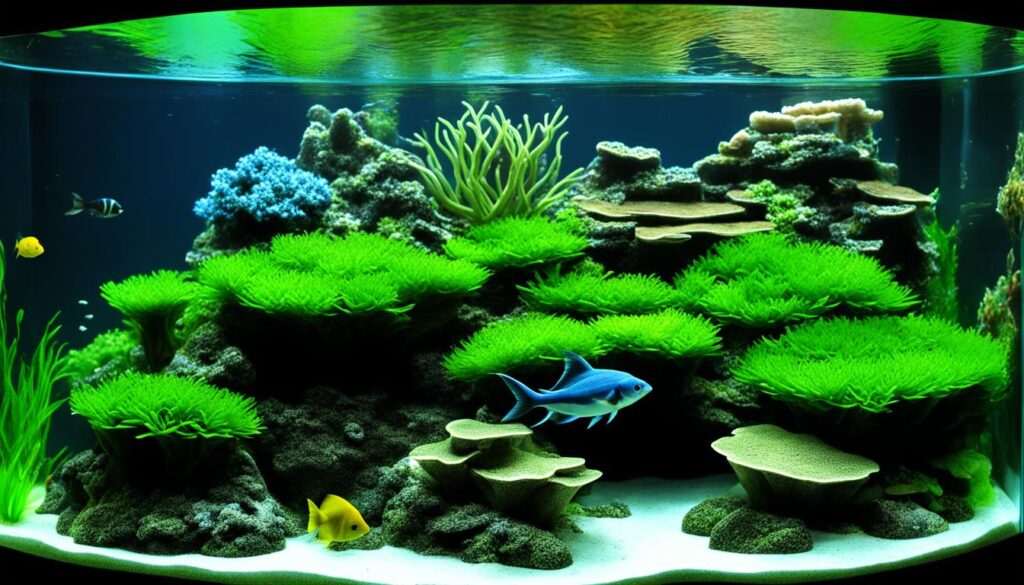
Essential Tools for Cycling
When it comes to successfully cycling your aquarium, there are a few essential tools you’ll need to ensure the process goes smoothly. These tools will help you monitor water parameters, introduce ammonia, and maintain clean and suitable water for your fish. Here are the must-haves:
Aquarium Test Kit
An aquarium test kit is an invaluable tool for any aquarium owner. It allows you to monitor important water parameters such as ammonia, nitrite, nitrate, pH, and more. By regularly testing your water, you can ensure that the nitrogen cycle is progressing as it should and make any necessary adjustments to maintain a healthy environment for your aquatic friends.
Fish Food
Introducing ammonia into your tank is a crucial step in the cycling process, and fish food is a convenient source. The fish food will break down, producing ammonia that will kickstart the growth of beneficial bacteria. Make sure to choose a high-quality fish food that is free from harmful additives.
Necessary Aquarium Components
Having the right components in your aquarium is essential for creating a conducive environment for the nitrogen cycle. This includes pumps, filters, heaters, and lights. These components help maintain water circulation, filtration, temperature, and lighting conditions necessary for the growth of beneficial bacteria and the overall health of your aquarium.
Water Filter
A quality water filter is key to ensuring clean and suitable water for your fish. Consider investing in a filter that utilizes reverse osmosis technology to remove impurities and pollutants effectively. This will help maintain optimal water conditions throughout the cycle and provide a healthy and stress-free environment for your aquatic inhabitants.
Remember, investing in the right tools from the start will make the cycling process easier and more successful, setting the stage for a thriving and beautiful aquarium.

Step-by-Step Guide to Fishless Cycling
Fishless cycling is a crucial process in establishing a healthy nitrogen cycle in your aquarium. By following these steps, you can create an environment that promotes the growth of beneficial bacteria and ensures the success of your cycling journey.
Step 1: Substrate and Hardscape Setup
Begin by setting up your substrate and hardscape in the aquarium. Choose a substrate that is suitable for your specific aquatic setup, such as gravel or sand. Arrange your hardscape elements, such as rocks or driftwood, in a way that creates a visually appealing and natural-looking environment for your fish.
Step 2: Perform Ghost Feedings
Gather a small amount of fish food and add it to the aquarium. This will generate ammonia, which is an essential component of the nitrogen cycle. It’s important to monitor the levels of ammonia throughout the cycling process using an aquarium test kit to ensure they are within the appropriate range.
Step 3: Add Liquid Nitrifying Bacteria
Introduce a liquid nitrifying bacteria supplement to the aquarium. These products contain beneficial bacteria that kickstart the nitrogen cycle by converting ammonia into nitrite and then nitrate. Follow the manufacturer’s instructions for dosage and application.
Step 4: Transfer Established Filter Media
If you have an established filter in another tank, transfer some of the filter media, such as sponge or bio balls, to the new aquarium. This will introduce beneficial bacteria and help speed up the cycling process. Be sure to handle the filter media carefully and avoid rinsing it in tap water, as it may contain chlorine or other harmful substances.
Continue monitoring the water parameters throughout the cycling process and make any necessary adjustments to maintain optimal conditions. Be patient, as the cycling process typically takes several weeks to complete. Once you have established a stable nitrogen cycle, you can safely add fish to your aquarium.
| Step | Description |
|---|---|
| 1 | Set up substrate and hardscape |
| 2 | Perform ghost feedings |
| 3 | Add liquid nitrifying bacteria |
| 4 | Transfer established filter media |
Remember, fishless cycling is a humane and effective method of establishing a healthy nitrogen cycle in your aquarium. By following these steps, you can create a thriving aquatic ecosystem for your fish, shrimp, and plants.

Step-by-Step Guide to Fish-In Cycling
Fish-in cycling can be a successful method for establishing a healthy nitrogen cycle in your aquarium while introducing fish at the same time. However, it requires careful monitoring and management to ensure the well-being of the fish. Here’s a step-by-step guide to help you navigate the fish-in cycling process:
Tank Component Setup
Before introducing any fish, it’s crucial to set up the necessary components of your tank. This includes:
- A suitable tank with appropriate size and dimensions
- Proper filtration system to maintain water quality
- Aquarium heater to regulate water temperature
- Substrate and decorations for aesthetic appeal and hiding spots
Ensuring that your tank is properly equipped will provide a comfortable and safe environment for the fish during the cycling process.
Gradual Fish Introduction
When starting a fish-in cycle, it’s important to introduce a small number of hardy fish gradually. This allows the beneficial bacteria in the tank to establish and keep up with the ammonia produced by the fish. Adding too many fish at once can overwhelm the bacteria and lead to harmful ammonia spikes.
Note: Consult with your local fish store or a knowledgeable aquarist to determine the appropriate number and species of fish for your specific tank size and setup.
Water Changes
Regular water changes are essential during fish-in cycling to maintain good water quality and minimize stress on the fish. Aim to perform partial water changes of about 25% every few days or as needed. Be sure to treat the new water with a suitable dechlorinator to remove chlorine and other harmful chemicals.
Note: Monitoring water parameters, such as ammonia, nitrite, nitrate, pH, and temperature, is crucial during fish-in cycling. Regular testing will help you assess and adjust the conditions to ensure the health and well-being of your fish.
Fish-In Cycling Guidelines
| Step | Action |
|---|---|
| 1 | Set up tank components (filtration system, heater, substrate, decorations) |
| 2 | Gradually introduce a small number of hardy fish |
| 3 | Monitor water parameters regularly |
| 4 | Perform partial water changes (about 25%) every few days |
| 5 | Treat new water with a suitable dechlorinator |
Following these guidelines will help you successfully navigate the fish-in cycling process. Remember to prioritize the health and well-being of your fish throughout the process.
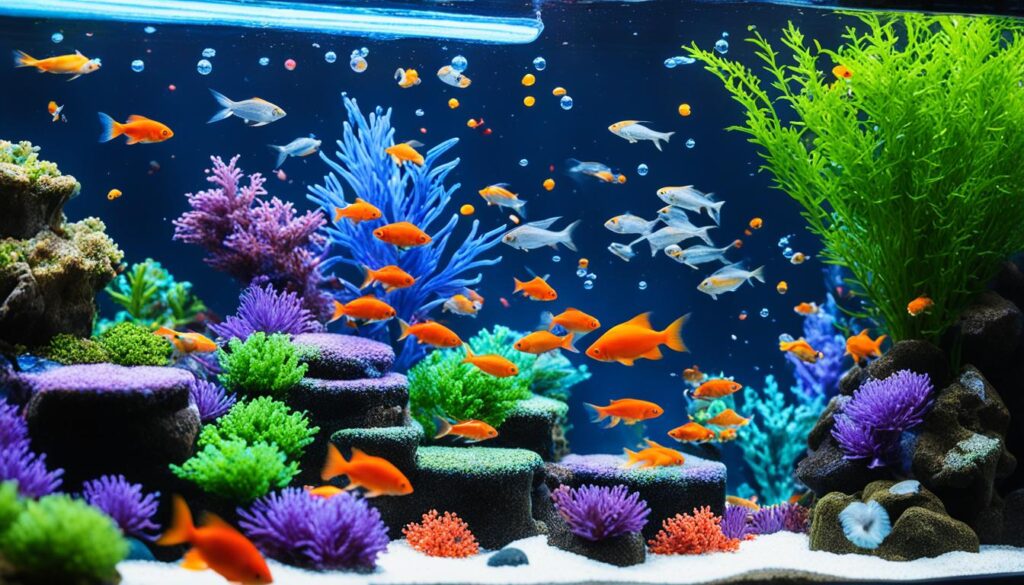
Myths and Misconceptions About Cycling
When it comes to aquarium cycling, there are a few myths and misconceptions that have been floating around. Let’s address some of the common misconceptions to ensure you have a proper understanding of the process.
Cycling Myth: Removing Filter Gunk
One common misconception is that removing filter gunk during the cycling process can hinder the growth of beneficial bacteria. However, it is important to clean your filter regularly to prevent clogs and maintain optimal water flow. While removing excessive debris is necessary, a light cleaning will not remove all the beneficial bacteria and will actually help maintain a healthier aquarium environment.
Cycling Myth: Inhibiting Bacterial Growth with High Nitrite or Ammonia Levels
Some aquarists believe that having high nitrite or ammonia levels during cycling can inhibit the growth of beneficial bacteria. This is not true. In fact, these bacteria thrive in the presence of these compounds, as they use them as a food source. It is important, however, to monitor ammonia and nitrite levels and keep them within safe limits to prevent harm to your fish.
Cycling Myth: Fishless Seeding Misconceptions
There are misconceptions about fishless seeding methods used during aquarium cycling. Some believe that adding ammonia alone is sufficient for establishing beneficial bacteria. While ammonia is necessary, using a combination of ammonia and liquid nitrifying bacteria or established filter media from another tank can expedite the cycling process. This helps introduce a diverse microbial population that will support a healthier ecosystem.
By debunking these myths and misconceptions, you can approach aquarium cycling with confidence and ensure a successful establishment of your aquatic ecosystem.
Benefits of a Mature Aquarium
A mature aquarium offers numerous benefits for your fish and plants. When your aquarium reaches a mature state, it means that the ecosystem is stable and the necessary beneficial bacteria have been established. This creates a more balanced and suitable environment for your aquatic inhabitants.
Improved Water Quality
One of the major advantages of a mature aquarium is the maintenance of improved water quality. The presence of beneficial bacteria helps to break down and convert harmful compounds, such as ammonia and nitrite, into less toxic nitrate. This reduces the risk of ammonia spikes, which can be detrimental to the health of your fish and plants.
Stable Ecosystem
A mature aquarium also signifies a stable ecosystem. The presence of beneficial bacteria helps establish a stable nitrogen cycle, ensuring a consistent supply of essential nutrients for your aquatic inhabitants. This stability promotes healthy growth and reduces the likelihood of sudden fluctuations in water parameters, which can stress or harm your fish and plants.
Creating a mature aquarium takes time and patience, but the rewards are well worth the effort. A stable ecosystem and improved water quality provide a healthier and more enjoyable environment for your fish and plants.
By allowing your aquarium to mature, you create a harmonious and self-sustaining ecosystem that is better equipped to support the needs of your aquatic inhabitants. This leads to happier and healthier fish, vibrant plants, and a thriving underwater world.
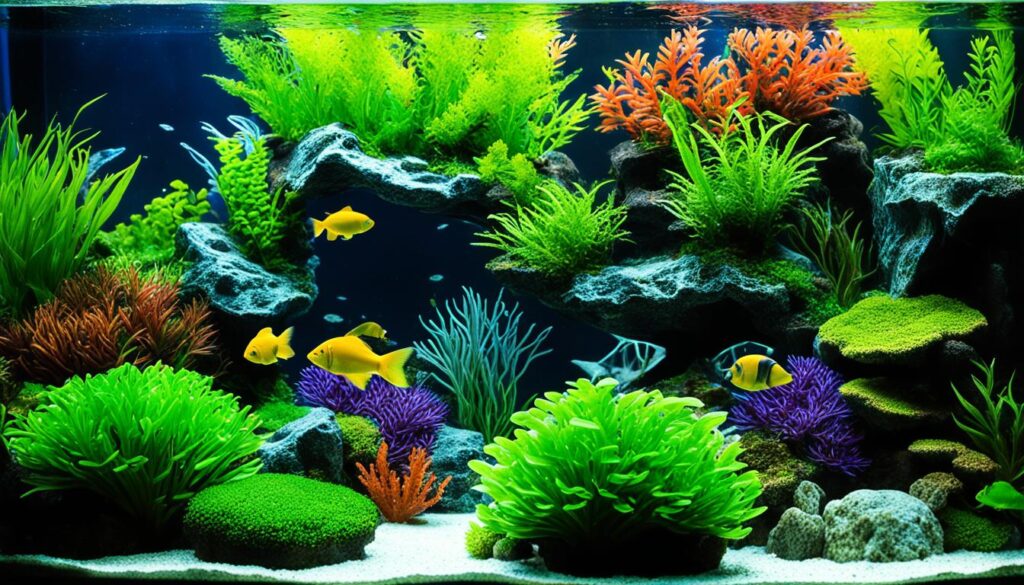
| Benefits | Description |
|---|---|
| Improved Water Quality | A mature aquarium helps maintain improved water quality by reducing the risk of harmful ammonia spikes and promoting the breakdown of toxic compounds. |
| Stable Ecosystem | The presence of beneficial bacteria in a mature aquarium creates a stable ecosystem, ensuring a consistent supply of essential nutrients for your aquatic inhabitants. |
Conclusion
In conclusion, DIY aquarium cycling techniques are crucial for creating a healthy and thriving aquatic environment. By understanding the nitrogen cycle and implementing the right cycling method, you can establish a balanced and safe ecosystem for your fish, shrimp, and plants.
Remember to be patient throughout the cycling process, as it can take several weeks for the nitrogen cycle to fully establish. Regularly monitor water parameters using an aquarium test kit to ensure optimal conditions for the growth of beneficial bacteria.
By making informed decisions and maintaining suitable water conditions, you can create the best environment for your aquatic friends. Investing time and effort in the cycling process will ultimately result in a flourishing aquarium with improved water quality and the well-being of your aquatic inhabitants.
FAQ
What is DIY aquarium cycling?
DIY aquarium cycling is the process of establishing a healthy nitrogen cycle in your aquarium by introducing beneficial bacteria to convert toxic ammonia into nitrite and then nitrate.
Why is understanding the nitrogen cycle important for aquariums?
Understanding the nitrogen cycle is essential for maintaining a healthy aquarium and preventing the harmful buildup of ammonia, which can be toxic to fish and other aquatic inhabitants.
What is a cycled tank?
A cycled tank is essential for a balanced and healthy aquarium. It means that the nitrogen cycle is actively occurring, and beneficial bacteria have established themselves in the tank, converting harmful ammonia and nitrite into less toxic nitrate.
What are the methods for fishless cycling?
Fishless cycling methods include ghost feedings, adding liquid nitrifying bacteria, or using established filter media from another tank. These methods help introduce beneficial bacteria and kickstart the cycling process without exposing your fish to harmful ammonia.
What are the risks of fish-in cycling?
Fish-in cycling involves adding fish to the tank during the cycling process. While it can be done successfully, it poses risks to the fish due to the high levels of ammonia that can accumulate in the tank. It is generally not recommended, especially for less hardy fish species.
How long does it take to cycle an aquarium?
The time it takes to cycle an aquarium can vary, but generally, it takes about four to eight weeks to complete the process. Monitoring water parameters and maintaining optimal conditions can help expedite the cycling process.
What are the essential tools for cycling an aquarium?
To successfully cycle your aquarium, you will need fish food to introduce ammonia, an aquarium test kit to monitor water parameters, necessary components such as pumps and filters, and a quality water filter to ensure clean and suitable water for your fish.
What are the steps for fishless cycling?
The steps for fishless cycling include setting up substrate and hardscape, performing ghost feedings, adding liquid nitrifying bacteria, and transferring established filter media. Each step contributes to the growth of beneficial bacteria and the successful cycling of your aquarium.
What are the steps for fish-in cycling?
The steps for fish-in cycling involve setting up tank components, gradually introducing a small number of hardy fish, and performing frequent water changes to maintain water quality. This method should be approached with caution and consideration for the well-being of the fish.
What are some myths and misconceptions about aquarium cycling?
Some common myths and misconceptions include removing filter gunk, inhibiting bacterial growth with high nitrite or ammonia levels, and misconceptions about fishless seeding methods. It’s important to clarify these misconceptions to ensure a proper understanding of the cycling process.
What are the benefits of a mature aquarium?
A mature aquarium, characterized by the presence of beneficial bacteria and a stable ecosystem, offers numerous benefits for your fish and plants. It helps maintain improved water quality, reduces the risk of ammonia spikes, and provides a more stable and suitable environment for your aquatic inhabitants.

